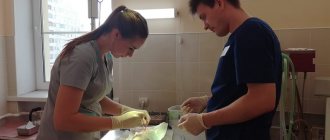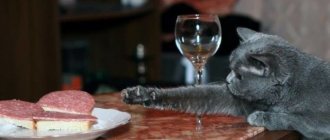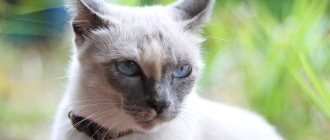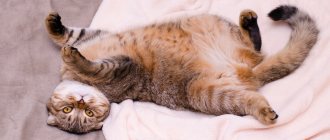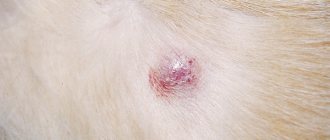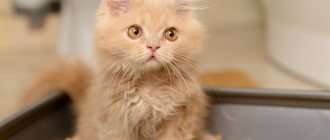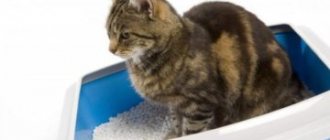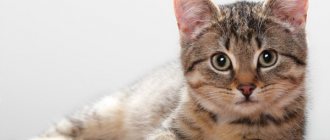Reasons and typology
Difficulty or cessation of the passage of food can be caused by a violation of motor function, in particular paralysis, or mechanical function of the intestines.
Mechanical intestinal obstruction in cats can be caused by a variety of factors:
- blockage of the intestines by a foreign object is the most common cause, since cats are prone to swallowing small household items (threads, needles, rags, toys, their own fur, etc.);
- neoplasms in the abdominal cavity, or directly in the intestinal wall itself;
- volvulus or torsion of the intestine;
- intussusception (that is, a condition in which one part of the intestine turns inside another part);
- hernias;
- abscesses or granulomas;
- adhesive disease;
- congenital anomalies, in particular intestinal diverticulum.
Symptoms of intestinal obstruction in cats
With partial obstruction, only part of the intestinal contents penetrates through the obstruction, and with complete obstruction, the movement of feed masses stops. Therefore, one of the symptoms is a small amount of feces or their complete absence. In both cases, in the area of the intestine where the blockage occurred, blood circulation is disrupted, which can lead to necrosis, that is, death of part of the intestine. Complete obstruction is characterized by severe clinical manifestations such as sudden onset of vomiting, depression, anorexia, abdominal pain and collapse. This condition is life-threatening for the animal and urgent surgical intervention is required.
The general condition of the cat depends on the degree of obstruction (low, medium, high), the size of the foreign body and the duration of the disease.
The following are the main symptoms of intestinal obstruction in cats:
- decreased appetite, sometimes reaching the point of complete refusal of food;
- periodic vomiting that occurs in most cases;
- reduction in the amount of feces or their complete absence;
- pain and increased abdominal volume;
- deterioration of general condition.
Dehydration of the body is also noted as a result of impaired water absorption and an imbalance of intestinal microflora. With prolonged fasting, exhaustion may occur, and as a result, the overall body temperature decreases (less than 37? C), general weakness occurs, and shortness of breath may occur. If help is not provided to a cat in this condition, this may result in the death of the animal.
Therefore, if the above clinical signs occur, you should immediately contact a qualified veterinarian at a veterinary clinic.
It should also be understood that each case is individual, and not all cats have pronounced symptoms. In some animals, intestinal obstruction may manifest itself with only a few of the signs listed above, so you should be attentive to your pets and pay special attention to even subtle changes in their condition.
Signs of rectal prolapse
With rectal prolapse, the intestine completely or partially falls out of the anus. In the initial stage, only the mucous membrane of the rectum can peek out from the outlet.
This happens immediately after bowel movement. The mucous membrane protrudes slightly.
You can visually see redness and swelling in the anal area. The cat behaves restlessly during defecation. Because of the pain, she meows and constantly licks herself.
Most often, in the initial stages of partial prolapse, the intestine retracts itself and returns to its place. Over time, if the cause is not eliminated, muscle tone will decrease and the intestine will no longer retract.
Since cats do not have hemorrhoids, redness and bulge in the area of the outlet indicate rectal prolapse.
With complete prolapse, the entire tubular structure of the intestine comes out. In this case, the intestine is compressed by the anus in the center. The fallen tissues have a bright scarlet color, they are inflamed and swollen.
If blood flow is obstructed, the intestine turns blue. If timely assistance is not provided, tissue necrosis will soon begin. The intestine will turn black and begin to become covered with ulcers. Tissue death can lead to sepsis.
The following degrees of rectal prolapse can be distinguished:
- First degree. Partial loss occurs after defecation. The intestine straightens itself after some time.
- Second degree. Complete prolapse of the intestine after defecation. You have to put it in place by hand.
- Third degree. Even a slight increase in intra-abdominal pressure leads to prolapse.
- Fourth degree. Any sudden movement can cause rectal prolapse.
Diagnosis of intestinal obstruction in cats
At the clinic, you should tell the doctor in detail about all the changes you notice in the cat’s condition. The specialist will carefully examine the animal; it may be necessary to take blood and urine tests to assess the condition at the time of treatment and rule out poisoning and infectious complications. Taking into account the general condition of the cat, the doctor prescribes a treatment regimen.
Most likely, a plain radiograph of the animal's abdominal cavity will be required. Intestinal ultrasound in this situation is not very informative, but sometimes you can see indirect signs of a foreign object, as well as evaluate peristalsis.
Fig.1. Wire in a cat's rectum
Plain radiography often does not provide enough information to make a diagnosis (unless the animal has a radiopaque foreign body), but it helps determine what part of the gastrointestinal tract is affected.
It should be remembered that not all objects can be seen on an x-ray. Needles, paper clips, stones, glass, and so on are radiopaque. But plastic, rubber, threads and other similar objects can only be detected with the help of an X-ray contrast agent. In this case, the cat is fed a contrast agent and a series of photographs are taken to track its passage through the digestive tract at 15 minutes, 30 minutes, 2 hours, 6 hours after the administration of the contrast agent, and then at the discretion of the veterinarian.
Rice. 2. Silk ribbon in the small intestine of a cat.
But palpation and radiography of the abdominal cavity usually make it possible to make a presumptive diagnosis and provide grounds for diagnostic surgery. This can be diagnostic laparotomy, laparoscopy, fibrogastroduodenoscopy (FGDS), during these studies the doctor conducts a more detailed examination of the organs of the digestive system.
Prevention of atony
To prevent difficulties in the digestive system and bowel movements, veterinarians at various clinics recommend that the cat owner follow the following rules:
- Feed the animal with high-quality feed or products.
- Ensure the supply of all necessary nutrients.
- Avoid hypothermia and stressful situations to normalize the animal’s psycho-emotional state.
- Be sure to play with your cat to increase muscle tone and physical health.
- Maintain cleanliness of the pet's premises and personal belongings.
A prerequisite for maintaining the health and well-being of a cat is the regularity and timeliness of preventive examinations, vaccinations and deworming. If negative symptoms occur, it is important to seek professional help and treat any underlying conditions.
Treatment of intestinal obstruction in cats
As a result of establishing the cause, further actions can be judged: either conservative therapeutic treatment of the sick animal is carried out, or emergency surgery is performed to eliminate the cause of blockage of the intestinal lumen (if a foreign body, hernia, tumor, etc. is detected).
Surgery is also necessary if symptoms persist or worsen, or if signs of peritonitis are noted.
In all cases, special attention should be paid to stabilizing the animal and restoring fluid and electrolyte balance after surgery.
What to do if you suspect intestinal obstruction in a cat
If you notice symptoms of intestinal obstruction in your pet or suspect that the cat may have swallowed any foreign objects, immediately seek help from a veterinary clinic!
Do not force feed or water your cat, as this may cause vomiting. You should not give antiemetic drugs that do not have a therapeutic effect. Laxatives and drugs that enhance intestinal motility may in some cases be contraindicated, since their action can lead to intestinal rupture.
Clinical signs may not always be clear, so you need to contact a qualified specialist at the clinic as soon as possible, since the clinic has all the necessary equipment for a speedy diagnosis.
How can I help the animal?
Without help, the animal will suffer, its condition will gradually worsen and lead to serious health consequences. It is possible to cure constipation with medicinal metabolites or traditional medicine.
Veterinary drugs
What to give your pet if he doesn't walk much? Laxatives are used to treat constipation. They improve intestinal motility, soften stool and gently remove it out. Pets are given Duphalac, Lactusan.
Duphalac changes the microflora of the large intestine, increasing the number of lactobacilli. The laxative effect is very mild, achieved without affecting the mucous membrane and smooth muscles.
Lactusan prevents intestinal dysbiosis. The drug stimulates the growth of acidophilus bacteria and removes toxins from the body.
Enema: pros and cons
Is it possible to give an enema if the cat has not gone to the toilet for 3-4 days? This procedure is carried out only if the pet's owners are confident that they can perform it correctly. Without proper experience, there is a high risk of injuring the animal by incorrectly calculating the amount of water or the angle of administration of the enema.
The water temperature should be slightly above room temperature. 50 ml is enough for administration. The tube is inserted to a depth of 5–7 mm. The animal must first be calmed and immobilized by wrapping it in a towel. The manipulations are carried out in the bathroom, which will then be easy to clean.
Vaseline or castor oil?
Vaseline oil has a mild laxative effect. Some pets really like its taste and are ready to lick it off their owners’ fingers. For picky cats, it is poured into the mouth using a syringe. Vaseline oil coats the intestinal walls, softens feces and quickly removes them naturally. Dosage – 1.5 ml of petroleum jelly per 1 kg of animal weight.
Another popular laxative, castor oil, is strictly prohibited. Cats cannot tolerate it; castor oil causes severe pain in the animal's stomach.
Folk remedies
Traditional methods will help in treating constipation. Decoctions of the following plants are added to the cat’s water:
- rhubarb (root);
- buckthorn (extract);
- cumin (fruit);
- dill;
- sea kale.
Regular condensed milk will help empty your intestines. The thick sweetness is diluted with water in a ratio of 1 to 1 and given to the pet 1 tablespoon per hour for 5 hours a day. Treatment should be continued until the stool returns to normal.
Clinical case of treatment of intestinal obstruction in a cat
The cat Izyum was admitted to the Pride Veterinary Center with complaints of repeated vomiting with blood and refusal to feed for three days.
During an examination by veterinary therapist A. M. Vasilyeva, a thread was discovered under the tongue. After X-ray diagnostics with contrast, a diagnosis of intestinal obstruction was made. Surgeon A.K. Mamedkuliev performed surgery and the thread was completely removed.
At the moment, Izyum’s condition is excellent, he is undergoing treatment at home.

